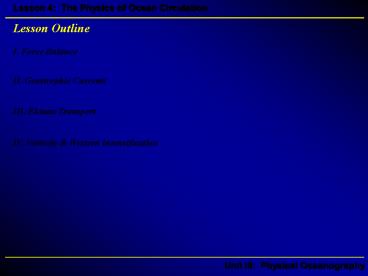Lesson Outline PowerPoint PPT Presentation
1 / 12
Title: Lesson Outline
1
Lesson Outline
I. Force Balance
II. Geostrophic Currents
III. Ekman Transport
IV. Vorticity Western Intensification
2
Physics of Ocean Currents
- All ocean currents are the result of the balance
of four forces
- Pressure gradient (sea surface height)
- Coriolis
- Wind stress
- Friction
3
The Horizontal Equations of Motion
The horizontal motion of ocean currents on the
rotating Earth are described by Newtons 2nd Law
of Motion (F ma), represented by the momentum
equation (Navier-Stokes equation)
The Coriolis parameter varies from .000146 s1
at the South Pole to .000146 s1 at the North
Pole. (f 0 at the equator)
4
Coriolis Acceleration
- Recall that the Coriolis deflection causes the
path of a water mass moving across latitudes to
bend (to the right in the northern hemisphere and
to the left in the southern).
The Coriolis acceleration, fv, varies with the
velocity and the latitude of the water mass.
The Coriolis force is absent at the equator, and
its strength increases as one approaches either
pole.
5
Geostrophic Currents
- The anticyclonic orientation of an ocean gyre is
due primarily to a balance between the pressure
gradient and Coriolis forces.
In general, such currents are said to be
geostrophic.
The pressure gradient force (gravity) acts to
push the water down the hill, while the Coriolis
force turns it to the right (in the northern
hemisphere).
The combination of forces causes the water to
flow around the high pressure, keeping it always
to the right of the flow.
6
Measuring Geostrophic Currents
- Geostrophic currents are calculated by measuring
the dynamic height of the water column
A CTD is lowered into the ocean to obtain a
vertical profile of the density, and the dynamic
height is calculated from the density.
After dynamic height calculations are made at
different stations, the direction and speed of
the geostrophic flow is determined from the slope
of the sea surface
7
Dynamic Height Maps
- In recent years, satellite mounted instruments
have been developed to measure the sea surface
height.
8
Ekman Transport
- The sea surface high in the center of the gyre is
maintained by the surface wind patterns over the
ocean at mid-latitudes.
In 1905, Walfrid Ekman presented a physical and
mathematical model to explain this phenomenon.
Ekman studied the balance between the wind stress
and Coriolis forces.
Ekmans model showed that water motion in the
surface wind layer spirals with depth.
The net water transport in the Ekman layer is 90º
to the right of the wind stress.
9
Ekman Pumping
- The change in the direction of the prevailing
winds around latitude N 30º results in a
convergence of the Ekman transport in the center
of the ocean gyre.
Sea water piles up into a mound. Gravity and
Coriolis deflection produce the subtropical
current gyres.
10
Vorticity
- Vorticity is the ability of a flow field to
impart a spin.
Vorticity can be visualized by considering how a
propeller would spin when placed horizontally in
the flow.
Along the ocean gyre, the vorticity must balance
everywhere.
11
Vorticity Balance
- The three forces capable of putting a torque
(twist) on the flow the Coriolis, wind stress,
and friction.
Changes in wind speed and direction in the
subtropical latitudes put a clockwise torque on
surface waters.
The Coriolis force, which increases toward the
poles, imparts a counter-clockwise torque on the
eastern boundary current.
Southward Flow Coriolis and wind stress balance
On the eastern side of the ocean, the vorticity
is balanced between the wind stress and Coriolis
forces.
12
Western Intensification
- On the western side of the ocean, the vorticity
produced by wind stress and the Coriolis force do
not balance.
To produce friction between the current and the
continental land mass, the currents on the
western side get narrower and intensify.

